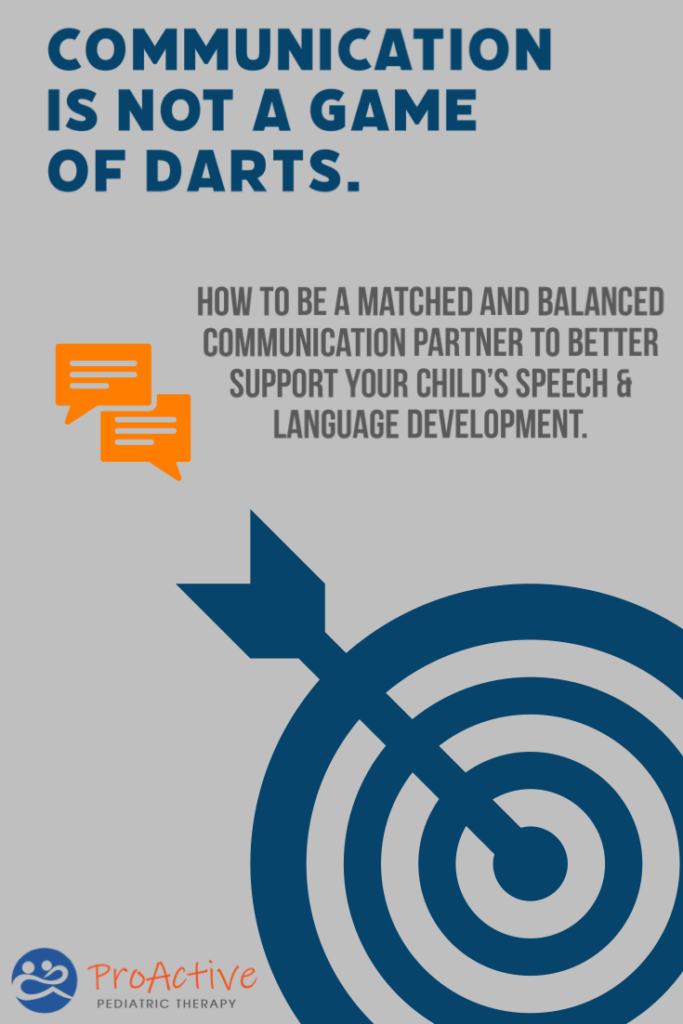One of the most effective strategies we can use as adults when interacting with our children to support their speech and language development is matching our communication to theirs and ensuring interactions are balanced.

Be a Matched Communication Partner.
- This means that we should speak at a level that is similar to where your child is speaking. If your child is not yet using words, then we should be modeling single word utterances that are paired with gestures and/or other fun movements. (because children learn to imitate actions and gestures before sounds and words!) If your child is using single words, then we would be speaking in 1-2-word utterances.
- Try to expand on what your child said by repeating the word they used then adding a new word to it. The most powerful expansions include one of your child’s targets. In an expansion, you imitate what the child communicated, and then add more. By adding words to the child’s words you connect a new word to a word your child already knows. which increases the saliency of the new word and makes it more likely that your child will learn this new word. Expansions immediately connect the child’s communication to additional new communication and help your child learn new vocabulary and talk in more complex sentences.
Be Balanced:
- Avoid dominating turns with your child. Remember, communication is like a game of ping-pong, not a game of darts. Our children are learning to talk, which is a tough thing to do! So when we ask a question or make a comment, we must be sure to provide children that extra wait time they need to process what they just heard and then formulate their own response.
- To provide wait time, after you have initiated communication, look at your child expectantly but remain silent. I physically count to 5 in my head to help me because silence is uncomfortable. we are quick to interject with another comment to fill that silene when in reality, we may be eliminating an opportunity for our child to share his own thoughts or feelings. You would be amazed by how much someone has to say when we just give them the opportunity to do so.
- If after 5 seconds your child does not respond, simply model the desired word/phrase and move on. Do not force or require your child to imitate it. Just model what it should sound like and continue on to the next activity. This helps reduce any pressure the child may feel during communicative interactions.
Children learn to speak by watching us and copying us. They are not born with the innate ability to do this. That means we must be providing them opportunities to learn from us. Be Matched by setting up opportunities for them to practice by using simple words and phrases. Your child is much more likely to imitate this vs if we used a 6-7-word sentence. Secondly, be balanced. Do not dominate the interaction by drilling questions at them like you would in game of darts. After you make a comment or ask a question, provide extended wait time to give your child a chance to respond. If they do not respond after 5-6 seconds, then model you could model what they could have said and move on.
Examples:
Instead of this:
Child: Ball
Adult: Wow! Watch this! I am going to kick this big ball all the way over there!
Try THIS:
Child: ball
Adult: a blue ball!!
(While on the slide)
Child: go
Adult: go dooooown! Wee!
Your child and family will flourish with the support of our team. You're not alone in your child's growth and development journey.
looking for answers to your questions and concerns?
You’re in the right place.
Contact
Resources
Therapists
Services
About
Joyfully serving infants & children in Hiawatha, Cedar Rapids, Marion, and surrounding Iowa communities
Patient Forms
designed by Melissa Meis
privacy policy
all rights reserved
1717 Boyson Rd, Hiawatha, IA 52233 | (319) 200-2004
Email: info@proactivepediatrictherapy.com